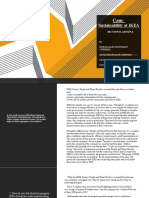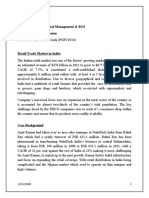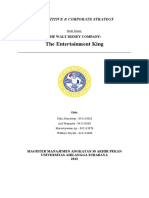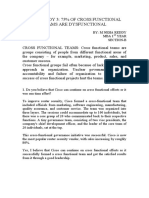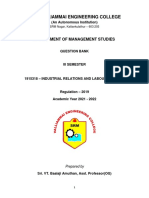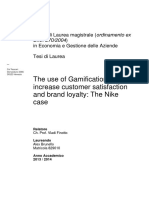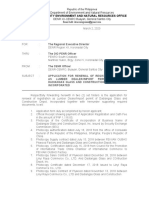Case Study 2: Sustainability of Ikea Group
Case Study 2: Sustainability of Ikea Group
Uploaded by
neha reddyCopyright:
Available Formats
Case Study 2: Sustainability of Ikea Group
Case Study 2: Sustainability of Ikea Group
Uploaded by
neha reddyOriginal Title
Copyright
Available Formats
Share this document
Did you find this document useful?
Is this content inappropriate?
Copyright:
Available Formats
Case Study 2: Sustainability of Ikea Group
Case Study 2: Sustainability of Ikea Group
Uploaded by
neha reddyCopyright:
Available Formats
CASE STUDY 2: SUSTAINABILITY OF IKEA
GROUP
BY: M NEHA REDDY
MBA 1ST YEAR
SECTION-B
1. What strategy would you recommend for IKEA for its wood
sustainability without compromising its growth target for 2020?
Ans. In 2014, the IKEA group launched an aggressive growth strategy
that included expanding its number of stores around the world and
expanding its range of customer targets in order to achieve sales growth
of a factor of two by 2020, as well as a comprehensive sustainability
strategy called "People & Planet Positive" that began with the material
base and extended to customers' lifestyles in order to help them achieve
their strong will - growth in a balanced and sustainable way.
The strategies that I would recommend for IKEA for its wood
sustainability without compromising its growth target for 2020 are
IKEA may be able to acquire more forest area, allowing them to
vertically integrate their supply chain. It would also enable them to
obtain more FSC certified wood, allowing them to diversify their
procurement away from China's expensive wood market. In the end, it
would give them complete control over the manufacturing process.
Setting a goal to use more FSC certified and recycled wood can help
IKEA achieve greater procurement targets and standards. This choice
would assist IKEA in increasing production efficiency, demonstrating
a commitment to sustainability, and improving forest governance
control.
IKEA can utilize more particleboard, reducing the amount of wood
they consume in the process. This not only saves money (by roughly
20%), but it's also easier to carry and provides for an increase in truck
loading efficiency.
IKEA can use more recycled wood as it is cheaper than particleboard.
2. Do you think IKEA’s "People & Planet Positive" strategy would be
relevant for meeting its 2020 goal?
Ans. IKEA has created a "People and Planet Positive" sustainability
strategy. This strategy aims to make people's homes more sustainable and
to improve people's lives and the lives of their communities. This IKEA
sustainability strategy comprises resource and energy independence
programs that reduce waste while limiting the consumption of the planet's
resources and replacing them with recycled and renewable materials.
In each of these sectors, IKEA has had success. This demonstrates the
plan's effectiveness in terms of long-term profitability and environmental
commitment, in addition to the cost savings provided through sustainable
procurement. IKEA has also been working to improve its relationships
with suppliers and employees, resulting in improved working conditions,
demonstrating their corporate social responsibility. They have also been
offering new subsets of furniture to suit to their customers' lifestyles,
demonstrating their dedication to them.
Finally, the IKEA Group's People and Planet Positive Plan entails a full
transformation of the company's value and supply chain, as well as
sustainable sourcing, improved labour conditions, increased efficiency,
and profit maximization, among other things. This approach will
undoubtedly aid the organization in its transformation and is inextricably
linked to the company's ambition to expand. The overall strategy is
ambitious, yet doable given the company's commitment to attaining its
objectives. IKEA's 22-person corporate Sustainability Group, which
works to implement each element of the People and Planet Positive
agenda, is systematically planning each step.
Yes,I think IKEA’s "People & Planet Positive" strategy would be
relevant for meeting its 2020 goal.
3. What are the main challenges in sourcing sustainable wood?
Ans. Long multinational supply chains can make tracing sustainability
more complex. Nearly 1.6 million people world wide rely on the local
forests for their livelihood who are not protected by their respective
governments. Harvesting virgin forests and clearing land for plantations
posed a serious threat to the lives of many people.
Natural forest management had an unavoidable impact on biodiversity
and ecological processes, and the conversion of natural habitats to timber
plantations significantly reduced biodiversity.
By preventing photosynthesis from sequestering atmospheric carbon into
the soil, deforestation is a major contributor to global climate change. It
also limited long-term wood availability, which was a particular worry in
China, which already had a significant timber trade deficit.
You might also like
- Case Study 1: The Inexorable Rise of WALMART 1988-2016Document2 pagesCase Study 1: The Inexorable Rise of WALMART 1988-2016neha reddyNo ratings yet
- ERGONOMICA CONSULTING AND SOLLTRAM HOTELS-SummaryDocument5 pagesERGONOMICA CONSULTING AND SOLLTRAM HOTELS-SummaryHitesh Singh RajpurohitNo ratings yet
- Case Study 4: Mcdonald India:Optimizing The French Fries Supply ChainDocument3 pagesCase Study 4: Mcdonald India:Optimizing The French Fries Supply Chainneha reddyNo ratings yet
- The Story of Marcus by Goldman SachsDocument1 pageThe Story of Marcus by Goldman SachsRam Pragadish0% (1)
- ASICS: Chasing A 2020 Vision-Case Write Up Rallapalli Vishal Vijay PGP10239Document1 pageASICS: Chasing A 2020 Vision-Case Write Up Rallapalli Vishal Vijay PGP10239RALLAPALLI VISHAL VIJAYNo ratings yet
- Case Analysis ReportDocument9 pagesCase Analysis Reportchirag shahNo ratings yet
- Netflix, Inc.-The Mouse Strikes Back SolutionDocument1 pageNetflix, Inc.-The Mouse Strikes Back SolutionArhamNo ratings yet
- Case-: Sustainability at IKEADocument7 pagesCase-: Sustainability at IKEAChander Lekha100% (1)
- Case Study 2: IKEADocument10 pagesCase Study 2: IKEAAzuati MahmudNo ratings yet
- Reaction Paper #6Document6 pagesReaction Paper #6Louelie Jean AlfornonNo ratings yet
- Zero To One PDFDocument9 pagesZero To One PDFIlse Dlz100% (1)
- Case#14 Analysis Group10Document7 pagesCase#14 Analysis Group10Mohammad Aamir100% (1)
- Gillette'S Energy Drain (A) : The Acquisition of DuracellDocument3 pagesGillette'S Energy Drain (A) : The Acquisition of DuracellNANo ratings yet
- The Overlooked Key To A Successful Scale-UpDocument16 pagesThe Overlooked Key To A Successful Scale-UptoanNo ratings yet
- (032121) (041021) Knowledge Management at Unilever IndonesiaDocument17 pages(032121) (041021) Knowledge Management at Unilever IndonesiaWiasta GuegueNo ratings yet
- Striders: Running Away or Towards The Growth (Group 8)Document1 pageStriders: Running Away or Towards The Growth (Group 8)Rashi VajaniNo ratings yet
- Natureview Case StudyDocument3 pagesNatureview Case StudySheetal RaniNo ratings yet
- PGP MAJVCG 2019-20 S3 Unrelated Diversification PDFDocument22 pagesPGP MAJVCG 2019-20 S3 Unrelated Diversification PDFBschool caseNo ratings yet
- 08 BrainardCaseAssignmentDocument2 pages08 BrainardCaseAssignmentZainabNo ratings yet
- Accounting: Accounting For Bitcoin at TeslaDocument19 pagesAccounting: Accounting For Bitcoin at TeslahuyNo ratings yet
- Final Grp1 Bay MadisonDocument11 pagesFinal Grp1 Bay MadisonDilip Thatti0% (1)
- Iggy's Bread of The World - Written Analysis and CommunicationDocument3 pagesIggy's Bread of The World - Written Analysis and CommunicationAshmitaSengupta50% (2)
- Group 3 - Bandhan BankDocument16 pagesGroup 3 - Bandhan BankAnisha KhandelwalNo ratings yet
- Case-Commerce Bank: Submitted By, Debarghya Das PRN No.18021141033Document5 pagesCase-Commerce Bank: Submitted By, Debarghya Das PRN No.18021141033Rocking Heartbroker DebNo ratings yet
- Case Analysis Topic - Working Capital Management & ROI Case - An Irate Distributor Submitted by - Srishti Joshi (PGFC1934)Document5 pagesCase Analysis Topic - Working Capital Management & ROI Case - An Irate Distributor Submitted by - Srishti Joshi (PGFC1934)Surbhi SabharwalNo ratings yet
- Case Analysis Sheet - Janki Solanki - 1813051Document5 pagesCase Analysis Sheet - Janki Solanki - 1813051Janki SolankiNo ratings yet
- ITC Hotels - Responsible LuxuryDocument35 pagesITC Hotels - Responsible LuxurySaurabh VermaNo ratings yet
- Business Strategy Analysis of ITCDocument6 pagesBusiness Strategy Analysis of ITCMukul GargNo ratings yet
- Summary and AnswersDocument9 pagesSummary and Answersarpit_nNo ratings yet
- Hindalco Novelis MergerDocument6 pagesHindalco Novelis Mergermonish147852100% (1)
- Itc IimkDocument17 pagesItc IimkAbhirami PromodNo ratings yet
- Honda or Hero HondaDocument16 pagesHonda or Hero HondaPrince SachdevaNo ratings yet
- A Case Study On TitanDocument4 pagesA Case Study On TitanVigil ViswanathanNo ratings yet
- A Successful Microfinance To Bank - A Case Study of BandhanDocument18 pagesA Successful Microfinance To Bank - A Case Study of BandhanSheetal ThomasNo ratings yet
- Hewlett-Packard (HP) Business Strategy ReportDocument33 pagesHewlett-Packard (HP) Business Strategy Reportjessica_liemNo ratings yet
- ONGC S Growth Strategy: Presented By-Amit Kumar Srivastava Ashwani Mishra Kuldeep DixitDocument11 pagesONGC S Growth Strategy: Presented By-Amit Kumar Srivastava Ashwani Mishra Kuldeep Dixitsrmashwani0% (2)
- Booz Allen Case StudyDocument4 pagesBooz Allen Case StudysmitaNo ratings yet
- Jackson Case Group5Document5 pagesJackson Case Group5SIDDHANT MOHAPATRANo ratings yet
- The New Years Eve CrisisDocument6 pagesThe New Years Eve CrisisDipta Bhanu BakshiNo ratings yet
- Business Law AssignmentDocument4 pagesBusiness Law AssignmentMOHIT SINGHNo ratings yet
- Group 8 - Managing The CompetitionDocument7 pagesGroup 8 - Managing The CompetitionAshish DrawkcabNo ratings yet
- Project CSMDocument39 pagesProject CSMrakeshNo ratings yet
- Store King Case StudyDocument13 pagesStore King Case StudyAnkit VisputeNo ratings yet
- Walt Disney Entertainment KingDocument7 pagesWalt Disney Entertainment KingInovasi daringNo ratings yet
- Sealed Air Corporation's Leveraged Recapitalization (A)Document7 pagesSealed Air Corporation's Leveraged Recapitalization (A)Jyoti Gupta0% (1)
- Case Study ON Flex Industries Limited: Prepared by Rohin MalhotraDocument5 pagesCase Study ON Flex Industries Limited: Prepared by Rohin MalhotraRohin MalhotraNo ratings yet
- A Term Paper On Itc LTDDocument32 pagesA Term Paper On Itc LTDDeepak KumarNo ratings yet
- Stamypor CaseDocument15 pagesStamypor CaserockysanjitNo ratings yet
- Kent Chemical: Organizing For International Growth: Strategy Implementation - Group 16Document8 pagesKent Chemical: Organizing For International Growth: Strategy Implementation - Group 16Rithesh KNo ratings yet
- Program: MBA-Master in Business Administration: Student: Mislav MatijevićDocument4 pagesProgram: MBA-Master in Business Administration: Student: Mislav MatijevićMislav MatijevićNo ratings yet
- Marriott CorporationDocument8 pagesMarriott CorporationtarunNo ratings yet
- West Marine CaseDocument8 pagesWest Marine CaseAkash Krishnatry50% (2)
- James Burke: A Career in American Business: Organizational Behaviour-II Group:BDocument6 pagesJames Burke: A Career in American Business: Organizational Behaviour-II Group:BRaman Yadav100% (1)
- Indco: Challenges of Designing and Implementing Customised TrainingDocument8 pagesIndco: Challenges of Designing and Implementing Customised TrainingAmit BiswalNo ratings yet
- Legal Aspects of Business 2E: Daniel AlbuquerqueDocument20 pagesLegal Aspects of Business 2E: Daniel Albuquerqueswati rathNo ratings yet
- Hindalco Novelis FINALDocument18 pagesHindalco Novelis FINALanushriNo ratings yet
- WellfleetDocument3 pagesWellfleetAziez Daniel AkmalNo ratings yet
- Group 9 - Carpenter Tan Handicraft CaseDocument10 pagesGroup 9 - Carpenter Tan Handicraft CaseJuhi SharmaBD21018No ratings yet
- Avari Ramada: Pricing Hotel RoomsDocument22 pagesAvari Ramada: Pricing Hotel RoomsSanjay SankhalaNo ratings yet
- Strategic HRM Plan at North Lands LedgerDocument9 pagesStrategic HRM Plan at North Lands LedgerStefano BarazzettaNo ratings yet
- The Gillette Company: Dry Idea Advertising Case Analysis: Integrated Marketing CommunicationDocument5 pagesThe Gillette Company: Dry Idea Advertising Case Analysis: Integrated Marketing CommunicationShachin ShibiNo ratings yet
- 01 396221 011 10138796043 25102022 025649pmDocument8 pages01 396221 011 10138796043 25102022 025649pmmishal zikriaNo ratings yet
- Sustainability & Ikea Supply Chain Assigment - Sec CDocument8 pagesSustainability & Ikea Supply Chain Assigment - Sec CRudra GoyalNo ratings yet
- Case Study 6: Exel PLC - Supply Chain Management at Haus MartDocument2 pagesCase Study 6: Exel PLC - Supply Chain Management at Haus Martneha reddyNo ratings yet
- Case Study 5: Iphones Supply Chain Under ThreatDocument3 pagesCase Study 5: Iphones Supply Chain Under Threatneha reddyNo ratings yet
- Case Study 3: Starbucks Corporation: Building A Sustainable Supply ChainDocument5 pagesCase Study 3: Starbucks Corporation: Building A Sustainable Supply Chainneha reddyNo ratings yet
- Case Study 3: 75% of Cross Functional Teams Are DysfunctionalDocument3 pagesCase Study 3: 75% of Cross Functional Teams Are Dysfunctionalneha reddyNo ratings yet
- McGraw Hill Connect Question Bank Assignment 3Document2 pagesMcGraw Hill Connect Question Bank Assignment 3Jayann Danielle MadrazoNo ratings yet
- Closure FormDocument4 pagesClosure FormbasantwadhwaNo ratings yet
- Contract 2022Document3 pagesContract 2022Tushar MottanaNo ratings yet
- ABAC SpinnDocument7 pagesABAC SpinnAndy KershawNo ratings yet
- Lecture - 5 - Slides - 1645283104982 Operation ManagenetDocument24 pagesLecture - 5 - Slides - 1645283104982 Operation Managenetvirender vermaNo ratings yet
- English - KertasDMS Brochure - 020322Document4 pagesEnglish - KertasDMS Brochure - 020322REBADULLA Jomari V.No ratings yet
- Industrial Relations and Labour WelfareDocument24 pagesIndustrial Relations and Labour WelfareBaalaji Amuthan ThangaveluNo ratings yet
- Banking Academy Faculty of International Business: International Trade and FinanceDocument10 pagesBanking Academy Faculty of International Business: International Trade and FinancePhạm LinhNo ratings yet
- The Philippine Competition Act (R.A. No. 10667)Document16 pagesThe Philippine Competition Act (R.A. No. 10667)julia4razo100% (1)
- 01 - Activity - 1 Faclities Management FinalDocument2 pages01 - Activity - 1 Faclities Management FinalTisha ParajeliNo ratings yet
- CDS CFI-AD Brochure - B ENG 2019-02Document12 pagesCDS CFI-AD Brochure - B ENG 2019-02kamilkaneNo ratings yet
- Use of Gamification For Customer SatisfactionDocument74 pagesUse of Gamification For Customer SatisfactionMinal KothariNo ratings yet
- Section 3 Movable and Immovable PropertyDocument15 pagesSection 3 Movable and Immovable PropertySatwant SinghNo ratings yet
- Meaning:: Recruitment: Meaning, Definition, Process and Factors Influencing Recruitment!Document3 pagesMeaning:: Recruitment: Meaning, Definition, Process and Factors Influencing Recruitment!Herman DjawaNo ratings yet
- Foreign Currency Derivatives Group 7Document53 pagesForeign Currency Derivatives Group 7Shean BucayNo ratings yet
- Ind. Renewal of Registration of Dadiangas GlassDocument2 pagesInd. Renewal of Registration of Dadiangas GlassCharish PantaleonNo ratings yet
- Port of Loading: Osaka, Japan. Port of Discharge: Saigon, VietnamDocument5 pagesPort of Loading: Osaka, Japan. Port of Discharge: Saigon, VietnamNguyễn LâmNo ratings yet
- Global Privacy Notice and Authori Sation: Please Read The Form Carefully, and Then Sign The Following DeclarationDocument3 pagesGlobal Privacy Notice and Authori Sation: Please Read The Form Carefully, and Then Sign The Following Declarationsumit singhNo ratings yet
- AFA (2021) - 02 - Consolidation Process and Intragroup TransactionsDocument68 pagesAFA (2021) - 02 - Consolidation Process and Intragroup Transactionsyu11111caoniNo ratings yet
- Bank ReconciliationDocument4 pagesBank Reconciliationrufamaegarcia07No ratings yet
- Larry Solomon EPAM PresentationDocument33 pagesLarry Solomon EPAM PresentationgamallofNo ratings yet
- FortiRewards EMEA Flyer 2022 Q3Document2 pagesFortiRewards EMEA Flyer 2022 Q3kadamtejal2010No ratings yet
- Se MCQ Unit 4Document6 pagesSe MCQ Unit 4MANISH SHARMANo ratings yet
- Browse The Book: First-Hand KnowledgeDocument43 pagesBrowse The Book: First-Hand Knowledgesri rNo ratings yet
- CBM 0016 Chapter 1 - The Practice of EntrepreneurshipDocument3 pagesCBM 0016 Chapter 1 - The Practice of EntrepreneurshipJames Matthew BedayoNo ratings yet
- Module II - Value Chain AnalysisDocument72 pagesModule II - Value Chain AnalysisloganathprasannaNo ratings yet
- Mina Danhoff ResumeDocument2 pagesMina Danhoff Resumeapi-538923547No ratings yet
- City of Tagbilaran: Holy Name UniversityDocument6 pagesCity of Tagbilaran: Holy Name UniversityVictoria CadizNo ratings yet







